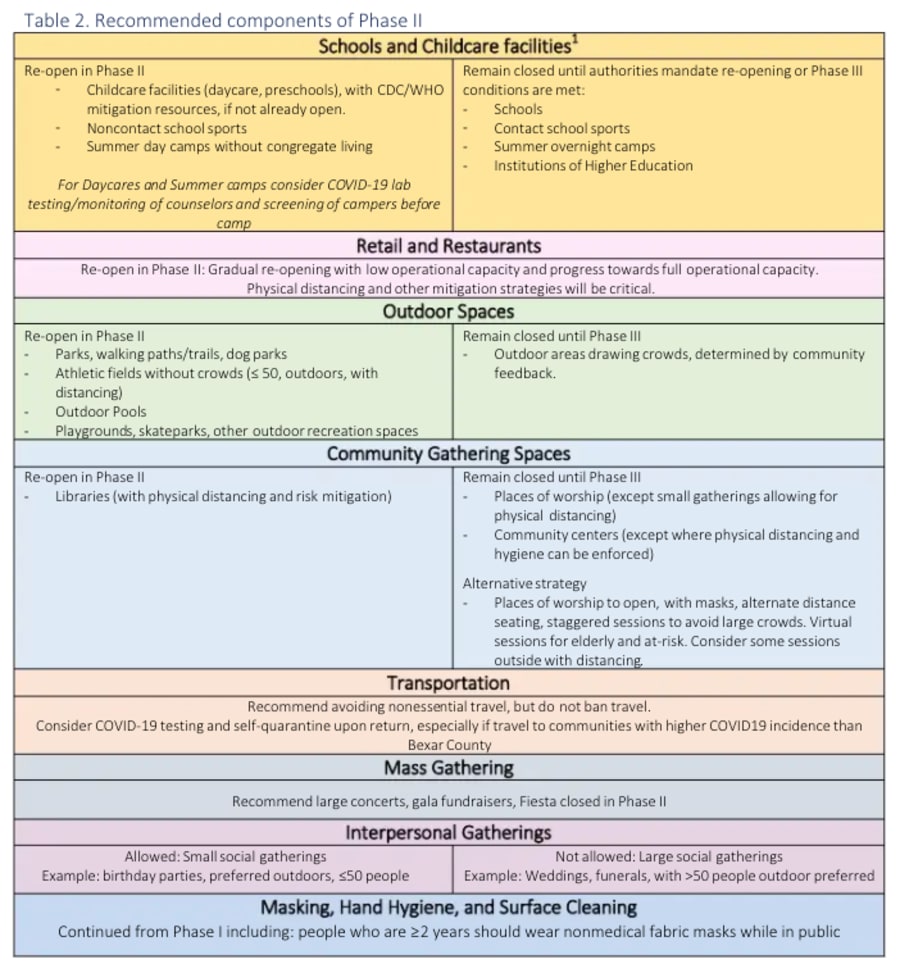SAN ANTONIO – While Texas Gov. Greg Abbott has already announced plans on how businesses will begin to reopen across the state, a team of local medical experts released their own report geared specifically toward San Antonio and Bexar County.
The COVID-19 Health Transition Team report, released Tuesday prior to a special joint meeting held by city council and the county commissioners court, provided local officials with a rough outline on how to ramp up activities while mitigating the risks of contracting COVID-19.
While the report is not a binding document, its intent is to provide guidance to local officials while they formulate reopening plans amid the coronavirus pandemic.
The four phases
The report lays out four phases of activity.
The first phase of the plan was the “Stay Home, Work Safe” order that officials put in place through the end of April.
Parts of the second phase of the plan will begin Friday, when the governor’s orders, which supersede local rules, allow some retail businesses, like malls and movie theaters, to reopen at reduced occupancies.
The local plan also encourages but doesn’t mandate residents to limit nonessential travel and for people over the age of 2 to wear a fabric mask when in public.
It also states that small social gatherings of fewer than 50 people may be held, but should be done so with caution and outdoors if possible. Weddings, funerals, concerts, galas and other large gatherings of more than 50 people are not allowed yet.
Locations and activities that would be allowed if phase two were fully implemented in the San Antonio area:
- Noncontact school sports
- Summer day camps without congregate living
- Retail and restaurants, malls, movie theaters, museums
- Parks, walking paths/trails, dog parks
- Athletic fields without crowds (less than 50 people, outdoors)
- Outdoor pools, playgrounds, skate parks and other outdoor
- Libraries
- Places of worship may operate if they take action to avoid large crowds, wear protective equipment and limit interaction with the elderly and other vulnerable people

The third phase will have more eased restrictions, but that won’t begin until an effective treatment or vaccine is established. The fourth phase represents a return to normal and emphasizes the need to prepare for the next potential pandemic.
Progress and warning indicators
Unlike the governor’s state order, the local report establishes progress and warning indicators that local officials are encouraged to monitor before opening up or restricting the economy. The progress indicators reflect an effective response, while the warning indicators are signs that more restrictions may be needed.
The progress indicators are:
- A sustained decline in the number of new COVID-19 cases over a 14-day period.
- The ability to perform tests for the virus in all people with COVID-19 symptoms, their close contacts, and anyone working in a public facing role.
- Effective contact tracing capacity to identify close contacts of people diagnosed with COVID-19.
- A prepared healthcare system that can safely care for patients and a steady supply of personal protective equipment.
The warning indicators are:
- A decrease in the number of days it takes for the number of COVID-19 cases to double (known as doubling time).
- An increase in the percentage of positive COVID-19 cases.
- An increase in indicators of health system stress, like reductions of PPE, hospital bed and ventilator capacity, and the number of calls made for emergency medical services.
Risk assessment by sector
Rather than determining which businesses are essential, the report defines different sectors by the potential for transmission of COVID-19.
The risk is determined by three characteristics:
- Contact intensity: Are people in this setting closer than 6 feet? How long are they in contact with each other?
- Number of contacts: How many people will be in the setting at once? The higher the number, the greater the risk.
- Modification potential: Can these settings modify the activity or setting to put in mitigation strategies recommended by the Centers for Disease Control and Prevention?
Retail sectors broken down by risk.
What needs to be addressed?
Although the city and county must follow what Abbott orders, the report lays out actions that should be taken to better assess and mitigate the spread of COVID-19.
The city must bolster its contact tracing, said Dr. Barbara Taylor, the associate dean of infectious disease at the University of Texas Health Science Center that put the report together. Taylor recommended the city hire 175 investigators to track infections.
Taylor also said the local testing capacity needs to double. Currently, roughly 1,600 tests can be conducted a day. Taylor said that capacity needs to increase to more than 3,000 tests a day.
The report also suggests local officials pay close attention to marginalized communities, which includes people with underlying health conditions, communities of color, the LGBTQ community and low-income communities. These groups have the highest risk of contracting COVID-19.
“Low-income people and people of color will experience the worst impacts of this crisis,” according to the report. “Therefore, now is the time to step up efforts to sustain equity gains that have already been made and secure more.”
Is this report enacted policy?
No. The team wrote this report over the span of a week and did not take the governor’s state orders into account.
While the statewide order is closely aligned with the local report, the governor’s orders would supersede any conflicting or contradictory policy at the local level.
MORE CORONAVIRUS COVERAGE FROM KSAT:










